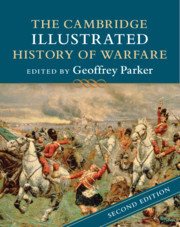Description
The Cambridge Illustrated History of Warfare (2nd Ed., Revised edition)
Cambridge Illustrated Histories Series
Coordinator: Parker Geoffrey
The new edition of The Cambridge Illustrated History of Warfare offers an updated comprehensive account of Western warfare.
Language: English
Subject for The Cambridge Illustrated History of Warfare:
The Cambridge Illustrated History of Warfare
Publication date: 08-2021
554 p. · 20.4x25.3 cm · Paperback
Publication date: 08-2021
554 p. · 20.4x25.3 cm · Paperback
The Cambridge Illustrated History of Warfare
Publication date: 08-2021
554 p. · 21.2x25.9 cm · Hardback
Publication date: 08-2021
554 p. · 21.2x25.9 cm · Hardback
Description
/li>Contents
/li>Biography
/li>
The new edition of The Cambridge Illustrated History of Warfare, written and updated by a team of nine distinguished military historians, examines how war was waged by Western powers across a sweeping timeframe, beginning with classical Greece and Rome, moving through the Middle Ages and the early modern period, down to the wars of the twenty-first century in Afghanistan, Iraq, and Syria. The book stresses five essential aspects of the Western way of war: a combination of technology, discipline, and an aggressive military tradition with an extraordinary capacity to respond rapidly to challenges and to use capital rather than manpower to win. Although the focus remains on the West, and on the role of violence in its rise, each chapter also examines the military effectiveness of its adversaries and the regions in which the West's military edge has been - and continues to be - challenged.
Preface; Introduction: The Western way of war Geoffrey Parker; Part I. The Age of Massed Infantry: 1. Genesis of the infantry, 600–350 BC Victor Davis Hanson; 2. From phalanx to legion, 350–250 BC Victor Davis Hanson; 3. The Roman way of war, 250 BC–AD 300 Victor Davis Hanson; Part II. The Age of Stone Fortifications: 4. On Roman ramparts, 300–1300 Bernard S. Bachrach; 5. New weapons, new tactics, 1300–1500 Christopher Allmand; 6. The gunpowder revolution, 1300–1500 Geoffrey Parker; Part III. The Age of Guns and Sails: 7. Ships of the line, 1500–1650 Geoffrey Parker; 8. The conquest of the Americas, 1500–1650 Patricia Seed; 9. Dynastic war, 1494–1660 Geoffrey Parker; 10. States in conflict, 1661–1763 John A. Lynn; 11. Nations in arms, 1763–1815 John A. Lynn; Part IV. The Age of Mechanized Warfare: 12. The industrialization of war, 1815–1871 Williamson A. Murray; 13. Towards world war, 1871–1914 Williamson A. Murray; 14. The West at war, 1914–1918 Williamson A. Murray; 15. The world in conflict, 1919–1941 Williamson A. Murray; 16. The world at war, 1941–1945 Williamson A. Murray; 17. The post-war world, 1945–1991 Williamson A. Murray; 18. The new world disorder, 1991–2019 Peter Mansoor and Geoffrey Parker; Epilogue: The future of Western warfare Geoffrey Parker and Leif A.Torkelsen; Reference guide; Chronology; Glossary; Bibliography; The contributors; Notes; Picture acknowledgements; Index.
Geoffrey Parker is Andreas Dorpalen Professor of European History and an associate of the Mershon Center at The Ohio State University. He has published forty books, including The Army of Flanders and the Spanish Road 1567–1659: The Logistics of Spanish Victory and Defeat in the Low Countries' Wars, The Grand Strategy of Philip II, and The Military Revolution 1500–1800: Military Innovation and the Rise of the West. His books have won numerous awards, and, in 2012, he received the biennial Heineken Prize in History, awarded by the Dutch Academy of Arts and Sciences to the historian deemed to have had the greatest impact on the discipline. In 2006, nominated by some of his students, he won Ohio State's Alumni Award for Distinguished Teaching. He has also directed thirty-five doctoral theses to completion, and, in 2013, his advisees presented him with a Festschrift in honour of his seventieth birthday: The Limits of Empire: European Imperial Formations in Early Modern World History.
© 2024 LAVOISIER S.A.S.
These books may interest you

The Cambridge History of Warfare 31.58 €



